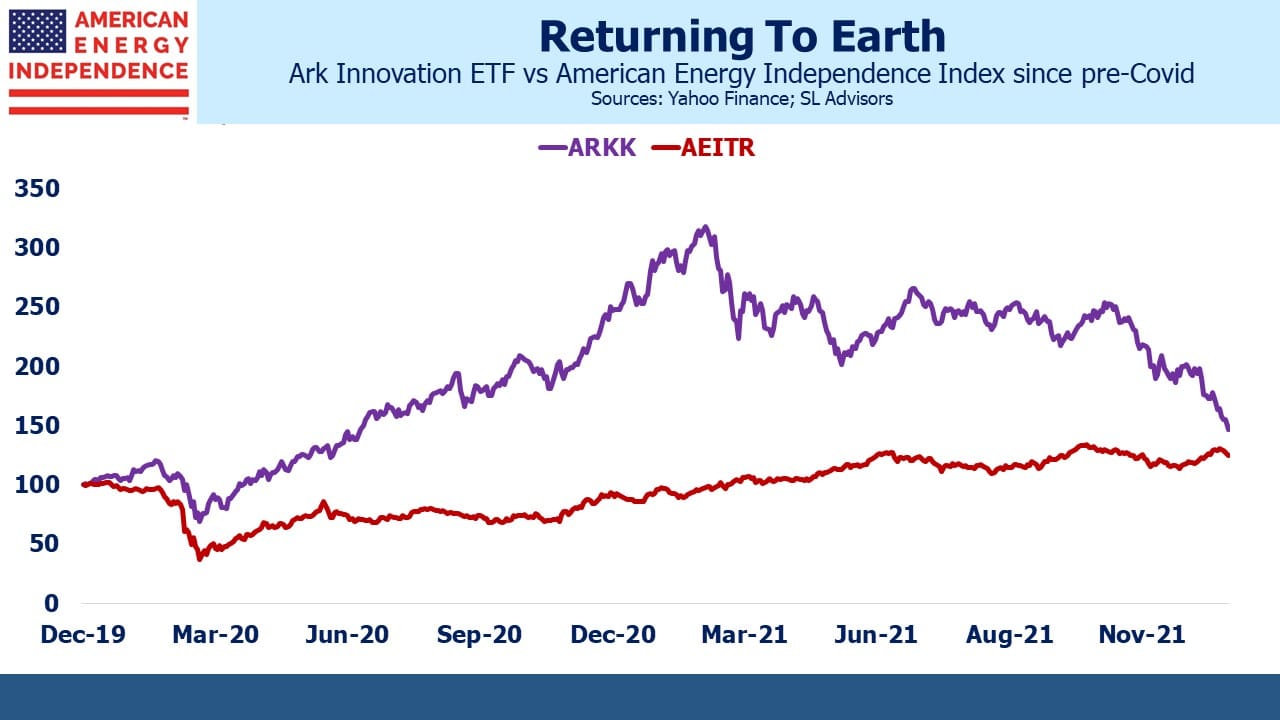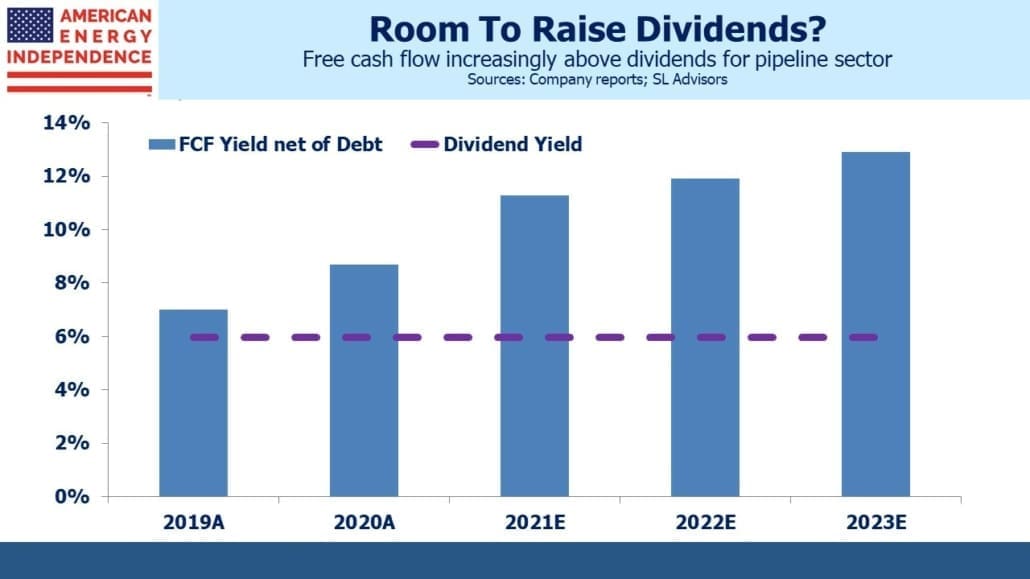The Bubble Was In ARKK’s Arc, Not Value Stocks
It’s easy to sympathize with Cathie Wood’s plaintive cry that value stocks look like a bubble. As long-time energy investors, we’ve watched awestruck as the ARK Innovation ETF (ARKK) traced out its stratospheric path for both performance and AUM. “Bubble” was a wholly inadequate sobriquet (see ARKK’s Investors Have In Aggregate Lost Money).
Having reached its apogee, there is now no pleasure in watching ARKK’s Icarus-like plunge. Pipeline investors were there a little over two years ago, when a sector that looked ridiculously cheap lost over half its value as Covid ravaged the energy sector.
We have no view on ARKK’s holdings, and little more to say on value stocks outside of energy, where we have much to add. Although momentum is extending the recent moves of ARKK and the pipeline sector, valuations of the latter provide ample justification for this to continue.
An overly exuberant Shale Revolution, the looming uncertainty of the energy transition and Covid’s demand destruction were the adverse trifecta that floored sentiment around traditional energy. April of 2020, when crude oil went briefly negative, represented a nadir of sentiment and valuation so severe it likely surpassed anything that came before.
The recency of such trauma continues to impose caution on prospective investors, allowing valuations to remain attractive. Flows into the sector are once again positive. Bubbles do not follow with such relative haste as Cathie Wood implies.
Industry capex appears parsimonious against the standards of five years ago, provoking incongruous pleas from the White House to produce more of something they claim to want phased out. CEOs such as Pioneer’s Scott Sheffield maintain that investors don’t want production that isn’t accretive on a per share basis. It took the last few years to convince them, but capital discipline remains the industry’s new religion.
An example is the growing spread between Distributable Cash Flow (DCF) and Capex. DCF is cash from operations minus maintenance capex (the cost of maintaining existing assets). Capex on new projects is down by almost two thirds for pipeline companies, similar to the reduced spending by E&P companies who are their customers. Many investors may be skeptical that such frugality will persist, but as Scott Sheffield’s comments show, financial performance is now more important than production growth.
Free Cash Flow (FCF) is being boosted by the DCF-Capex spread. Sources and uses of funds is an important variable. In projecting FCF we’ve assumed that half of growth spending is debt-financed, which would still allow leverage to continue decreasing while increasing payout coverage. We’ve made no assumptions about dividend hikes or buybacks, which are hard to forecast more than a year out. Both may trim FCF growth, but since these represent a direct return of additional cash to investors there would be little to complain about.
Increased capital discipline is occurring simultaneously with energy policies intended to inhibit supply growth. Political leaders routinely draw on professed public concern about climate change to provide legitimacy for related policies. However, there seems to be little political appetite to limit demand for reliable energy. The focus remains on the supply side, as if the energy transition can be painless to consumers with the disruption only on big corporations.
The result is that continued demand growth and constrained supply are boosting prices for natural gas, crude oil and even coal. Progressive policy prescriptions have failed to meaningfully impact emissions – but they have served to highlight the challenges of intermittency with renewables, inadvertently improving the outlook for traditional energy companies.
Emerging countries favor raising living standards over fighting global warming, and the most impactful step the world could take would be promoting natural gas over coal for power generation.
Moreover, midstream energy infrastructure companies will mostly own and manage the infrastructure needed for carbon capture, where increased Q45 tax credits enjoy bipartisan support. If hydrogen use becomes commercially viable, the same companies will manage that. In short, rather than threatening the pipeline sector, the energy transition is turning out to be impossible to execute without it.
Any economic threat posed by Covid has long since passed – the collapse in stocks like Peloton and Netflix shows that lockdown spending is dissipating as normalcy returns.
The result is that all three headwinds that hurt investment performance in midstream energy infrastructure have been converted to tailwinds. Meanwhile, valuations remain compelling. If some sellers of ARKK are fleeing to pipelines, they are drawn by the positive fundamentals listed above. They’re abandoning what was clearly a bubble in favor of solid fundamentals.
We have three funds that seek to profit from this environment:
Please see important Legal Disclosures.
Important Disclosures
The information provided is for informational purposes only and investors should determine for themselves whether a particular service, security or product is suitable for their investment needs. The information contained herein is not complete, may not be current, is subject to change, and is subject to, and qualified in its entirety by, the more complete disclosures, risk factors and other terms that are contained in the disclosure, prospectus, and offering. Certain information herein has been obtained from third party sources and, although believed to be reliable, has not been independently verified and its accuracy or completeness cannot be guaranteed. No representation is made with respect to the accuracy, completeness or timeliness of this information. Nothing provided on this site constitutes tax advice. Individuals should seek the advice of their own tax advisor for specific information regarding tax consequences of investments. Investments in securities entail risk and are not suitable for all investors. This site is not a recommendation nor an offer to sell (or solicitation of an offer to buy) securities in the United States or in any other jurisdiction.
References to indexes and benchmarks are hypothetical illustrations of aggregate returns and do not reflect the performance of any actual investment. Investors cannot invest in an index and do not reflect the deduction of the advisor’s fees or other trading expenses. There can be no assurance that current investments will be profitable. Actual realized returns will depend on, among other factors, the value of assets and market conditions at the time of disposition, any related transaction costs, and the timing of the purchase. Indexes and benchmarks may not directly correlate or only partially relate to portfolios managed by SL Advisors as they have different underlying investments and may use different strategies or have different objectives than portfolios managed by SL Advisors (e.g. The Alerian index is a group MLP securities in the oil and gas industries. Portfolios may not include the same investments that are included in the Alerian Index. The S & P Index does not directly relate to investment strategies managed by SL Advisers.)
This site may contain forward-looking statements relating to the objectives, opportunities, and the future performance of the U.S. market generally. Forward-looking statements may be identified by the use of such words as; “believe,” “expect,” “anticipate,” “should,” “planned,” “estimated,” “potential” and other similar terms. Examples of forward-looking statements include, but are not limited to, estimates with respect to financial condition, results of operations, and success or lack of success of any particular investment strategy. All are subject to various factors, including, but not limited to general and local economic conditions, changing levels of competition within certain industries and markets, changes in interest rates, changes in legislation or regulation, and other economic, competitive, governmental, regulatory and technological factors affecting a portfolio’s operations that could cause actual results to differ materially from projected results. Such statements are forward-looking in nature and involves a number of known and unknown risks, uncertainties and other factors, and accordingly, actual results may differ materially from those reflected or contemplated in such forward-looking statements. Prospective investors are cautioned not to place undue reliance on any forward-looking statements or examples. None of SL Advisors LLC or any of its affiliates or principals nor any other individual or entity assumes any obligation to update any forward-looking statements as a result of new information, subsequent events or any other circumstances. All statements made herein speak only as of the date that they were made. r
Certain hyperlinks or referenced websites on the Site, if any, are for your convenience and forward you to third parties’ websites, which generally are recognized by their top level domain name. Any descriptions of, references to, or links to other products, publications or services does not constitute an endorsement, authorization, sponsorship by or affiliation with SL Advisors LLC with respect to any linked site or its sponsor, unless expressly stated by SL Advisors LLC. Any such information, products or sites have not necessarily been reviewed by SL Advisors LLC and are provided or maintained by third parties over whom SL Advisors LLC exercise no control. SL Advisors LLC expressly disclaim any responsibility for the content, the accuracy of the information, and/or quality of products or services provided by or advertised on these third-party sites.
All investment strategies have the potential for profit or loss. Different types of investments involve varying degrees of risk, and there can be no assurance that any specific investment will be suitable or profitable for a client’s investment portfolio.
Past performance of the American Energy Independence Index is not indicative of future returns.





Leave a Reply
Want to join the discussion?Feel free to contribute!